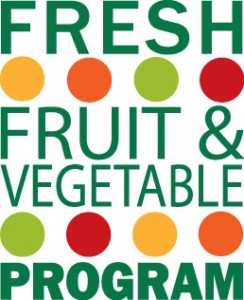 As I sat around the dinner table with my family recently, my son went into great detail about this food he had at school. He couldn’t remember the name, but he said it was kind of like a raw potato and also similar to an apple. He explained how they were given fresh lime to squeeze on it as a flavor enhancer. Totally perplexed, I got up to get the calendar from school to learn he had been sampling jicama. Jicama is just one of the many fruits and vegetables he and his peers are eating as part of the USDA Fresh Fruit and Vegetable Program.
As I sat around the dinner table with my family recently, my son went into great detail about this food he had at school. He couldn’t remember the name, but he said it was kind of like a raw potato and also similar to an apple. He explained how they were given fresh lime to squeeze on it as a flavor enhancer. Totally perplexed, I got up to get the calendar from school to learn he had been sampling jicama. Jicama is just one of the many fruits and vegetables he and his peers are eating as part of the USDA Fresh Fruit and Vegetable Program.
The Fresh Fruit and Vegetable Program (FFVP) began through the Farm and Security and Rural Investment Act of 2002. The purpose was to determine the best ways to get more fruit and vegetables consumed in the schools. The program was authorized as a pilot in only 4 states, but the popularity of the program added new states almost every year and today all 50 states are participating. The FFVP is provided to select schools through grants administered through the State Departments of Education. My son’s school, College Hill Elementary in Wichita, KS was fortunate enough to receive the grant this year. They have been seeing fantastic results.
It’s no secret that a strong battle is being fought in order to increase the quality of our school lunches and to teach our children what healthy eating looks like. As the elementary students at College Hill have been introduced to these fruits and vegetables, good results have been shown.
“I think most of the staff has been pleasantly surprised at how willingly the kids have at least tasted everything. I’m sure that we are giving quite a few of these kids an experience with some types of foods that they would never have in their lifetime,” said Karla Stenzel, physical education teacher and the facilitator of the FFVP.
I explained to Stenzel that my son has walked through the produce department with me pointing out items like blood oranges or fingerling potatoes and has nearly begged me to buy them because he enjoyed them so much at school. Assuming I wasn’t alone, Stenzel replied, “…elementary kids can’t buy groceries but they can ask their parents to buy certain things. Hopefully they are asking them to buy red pears instead of Pop Tarts once in a while now.”
The children are receiving one fresh fruit and one fresh vegetable a week. The calendar is a beautiful mix of items such as snow peas, kiwi, red cabbage, pomegranates, and romaine lettuce. Stenzel tells the children all about the food before it’s served and always includes a fun little story about it to get the kids excited. It seems to be working, as all the kids love talking about their produce when I came to the school and inquired about it. One of the children last week mentioned how much better the fresh pineapple tasted verses the only other type they ever had, “the kind in a can.”
It’s a huge battle to educate our kids and to redirect their taste buds from processed foods to real, nutritious foods. The FFVP may be one of the biggest steps the country is making. When my 8-year old is having to show me what jicama looks like, as I’ve never had it before, and instructing me, “you should really try it,” I can clearly see the impact this program is making.
The youngest children at the school may speak the loudest truths. After jicama and limes were served, the kindergartners had a variety of great things to say. “Do jicamas give you hiccups?” “I am going to have to ask my mommy to get jicamas.” The best of all was, “YUMMM!!!”
Also Read:
School Lunches Don’t Have to be Junk
The Great Salad Bar Project to Improve School Lunches
You Can Improve School Lunches During National School Lunch Week
